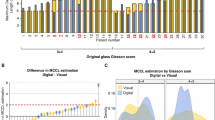Abstract
Our aims were to analyze reporting of Gleason pattern (GP) 3 and 4 prostate cancer with the ISUP 2005 Gleason grading and to collect consensus cases for standardization. We scanned 25 prostate biopsy cores diagnosed as Gleason score (GS) 6–7. Fifteen genitourinary pathologists graded the digital slides and circled GP 4 and 5 in a slide viewer. Grading difficulty was scored as 1–3. GP 4 components were classified as type 1 (cribriform), 2 (fused), or 3 (poorly formed glands). A GS of 5–6, 7 (3 + 4), 7 (4 + 3), and 8–9 was given in 29%, 41%, 19%, and 10% (mean GS 6.84, range 6.44–7.36). In 15 cases, at least 67% of observers agreed on GS groups (consensus cases). Mean interobserver weighted kappa for GS groups was 0.43. Mean difficulty scores in consensus and non-consensus cases were 1.44 and 1.66 (p = 0.003). Pattern 4 types 1, 2, and 3 were seen in 28%, 86%, and 67% of GP 4. All three coexisted in 16% (11% and 23% in consensus and non-consensus cases, p = 0.03). Average estimated and calculated %GP 4/5 were 29% and 16%. After individual review, the experts met to analyze diagnostic difficulties. Areas of GP 4 and 5 were displayed as heat maps, which were helpful for identifying contentious areas. A key problem was to agree on minimal criteria for small foci of GP 4. In summary, the detection threshold for GP 4 in NBX needs to be better defined. This set of consensus cases may be useful for standardization.


Similar content being viewed by others
References
Epstein JI, Allsbrook WC Jr, Amin MB, Egevad LL (2005) The 2005 International Society of Urological Pathology (ISUP) consensus conference on gleason grading of prostatic carcinoma. Am J Surg Pathol 29:1228–1242
Allsbrook WC Jr, Mangold KA, Johnson MH, Lane RB, Lane CG, Amin MB, Bostwick DG, Humphrey PA, Jones EC, Reuter VE, Sakr W, Sesterhenn IA, Troncoso P, Wheeler TM, Epstein JI (2001) Interobserver reproducibility of Gleason grading of prostatic carcinoma: urologic pathologists. Hum Pathol 32:74–80
Allsbrook WC Jr, Mangold KA, Johnson MH, Lane RB, Lane CG, Epstein JI (2001) Interobserver reproducibility of Gleason grading of prostatic carcinoma: general pathologist. Hum Pathol 32:81–88
Carlson GD, Calvanese CB, Kahane H, Epstein JI (1998) Accuracy of biopsy Gleason scores from a large uropathology laboratory: use of a diagnostic protocol to minimize observer variability. Urology 51:525–529
Egevad L (2001) Reproducibility of Gleason grading of prostate cancer can be improved by the use of reference images. Urology 57:291–295
Lessells AM, Burnett RA, Howatson SR, Lang S, Lee FD, McLaren KM, Nairn ER, Ogston SA, Robertson AJ, Simpson JG, Smith GD, Tavadia HB, Walker F (1997) Observer variability in the histopathological reporting of needle biopsy specimens of the prostate. Hum Pathol 28:646–649
Berney DM, Fisher G, Kattan MW, Oliver RT, Moller H, Fearn P, Eastham J, Scardino P, Cuzick J, Reuter VE, Foster CS (2007) Major shifts in the treatment and prognosis of prostate cancer due to changes in pathological diagnosis and grading. BJU Int 100:1240–1244
Helpap B, Egevad L (2006) The significance of modified Gleason grading of prostatic carcinoma in biopsy and radical prostatectomy specimens. Virchows Arch 449:622–627
Delahunt B, Lamb DS, Srigley JR, Murray JD, Wilcox C, Samaratunga H, Atkinson C, Spry NA, Joseph D, Denham JW (2010) Gleason scoring: a comparison of classical and modified (International Society of Urological Pathology) criteria using nadir PSA as a clinical end point. Pathology 42:339–343
Deshmukh N, Foster CS (1998) Grading prostate cancer. In: Foster CS, Bostwick DG (eds) Pathology of the prostate. Saunders, Philadelphia, pp 191–227
Koch LH, Lampros JN, Delong LK, Chen SC, Woosley JT, Hood AF (2009) Randomized comparison of virtual microscopy and traditional glass microscopy in diagnostic accuracy among dermatology and pathology residents. Hum Pathol 40:662–667
Egevad L, Allsbrook WC Jr, Epstein JI (2005) Current practice of Gleason grading among genitourinary pathologists. Hum Pathol 36:5–9
Egevad L, Granfors T, Karlberg L, Bergh A, Stattin P (2002) Percent Gleason grade 4/5 as prognostic factor in prostate cancer diagnosed at transurethral resection. J Urol 168:509–513
Stamey TA, McNeal JE, Yemoto CM, Sigal BM, Johnstone IM (1999) Biological determinants of cancer progression in men with prostate cancer. JAMA 281:1395–1400
Stamey TA, Yemoto CM, McNeal JE, Sigal BM, Johnstone IM (2000) Prostate cancer is highly predictable: a prognostic equation based on all morphological variables in radical prostatectomy specimens. J Urol 163:1155–1160
Vis AN, Roemeling S, Kranse R, Schroder FH, van der Kwast TH (2007) Should we replace the Gleason score with the amount of high-grade prostate cancer? Eur Urol 51:931–939
Glaessgen A, Hamberg H, Pihl CG, Sundelin B, Nilsson B, Egevad L (2003) Interobserver reproducibility of percent Gleason grade 4/5 in prostate biopsies. J Urol 171:664–667
Billis A, Guimaraes MS, Freitas LL, Meirelles L, Magna LA, Ferreira U (2008) The impact of the 2005 international society of urological pathology consensus conference on standard Gleason grading of prostatic carcinoma in needle biopsies. J Urol 180:548–552, discussion 552–543
Egevad L, Algaba F, Berney DM, Boccon-Gibod L, Griffiths DF, Lopez-Beltran A, Mikuz G, Varma M, Montironi R (2009) The European Network of Uropathology: a novel mechanism for communication between pathologists. Anal Quant Cytol Histol 31:90–95
Acknowledgment
Source of support: DMB is supported by Orchid.
Conflict of interest statement
We declare that we have no conflict of interest.
Author information
Authors and Affiliations
Corresponding author
Rights and permissions
About this article
Cite this article
Egevad, L., Algaba, F., Berney, D.M. et al. Interactive digital slides with heat maps: a novel method to improve the reproducibility of Gleason grading. Virchows Arch 459, 175–182 (2011). https://doi.org/10.1007/s00428-011-1106-x
Received:
Revised:
Accepted:
Published:
Issue Date:
DOI: https://doi.org/10.1007/s00428-011-1106-x




